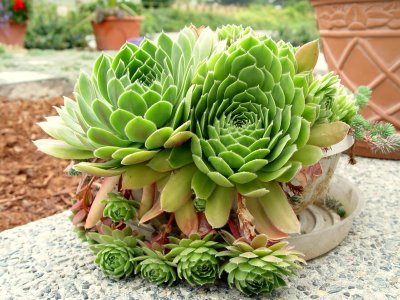
Succulent plants are so easy and fun to grow! And what a lovely, green addition they make to a garden bed or container. Succulents are a species that have water storing capabilities and have adapted to the arid climates of deserts and semi-deserts. They are frequently associated with high daytime temperatures and their special mechanisms which allow them to collect and conserve the limited moisture that is available from rain, dews, mists, and fogs. Because they do not require daily watering, they make wonderful container gardens in areas that are hot and dry.
Last summer I decided to add variety to my supply of succulent plants, but was disheartened to find that the nursery down the road charged dearly for their succulent stock. I purchased one or two plants, but decided to use the cutting method as a fast and inexpensive way to propegate them and enlarge my own collection. Friends and neighbors have been happy to share with me. A cutting produces a new plant which is genetically identical to the original specimen. Therefore, it's important that you only start cuttings from plants that are thriving and healthy. Most species of succulent plants can be started from pieces that are cut from the stem of the plant with a sharp knife. The best place to cut is just below a stem joint, or where a leaf or bud joins the stem. Be careful to remove the cuttings so that they do not spoil the original plant's shape. The new cutting can be placed directly into a container of potting soil, sand, or vermiculite. With occasional water and indirect sunlight, they will root and grow, eventually reproducing and forming new small plants. Although Spring is usually the best time to take cuttings and start them in a growing medium, Autumn or Winter will also work if they are of a variety that continues growing during those seasons.
Eventually, most species of succulent plants will produce tiny plants at the base of the parent plant. These new plants can be easily plucked or cut off of the main stem and replanted in new pots for continued propegation. Doing this benefits the main plant because energy is not diverted from the main plant to the smaller ones. In order to grow a large solitary specimen, this is recommended.

Photos: Alma's 'Hen and Chicken' container garden. It thrived this summer with sunshine, water, and occasional feeding. Isn't it beautiful?

Yes, I sure know how those toddlers can be! Yours is a cutie pie! I have hen and chicks on a piece of driftwood also. It was my mom's creation, and when she passed away, I saved it from her garden and brought it home. I think of her whenever I look at it.
ReplyDelete